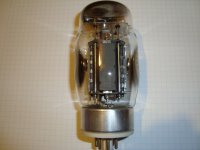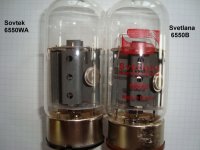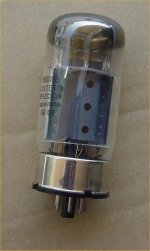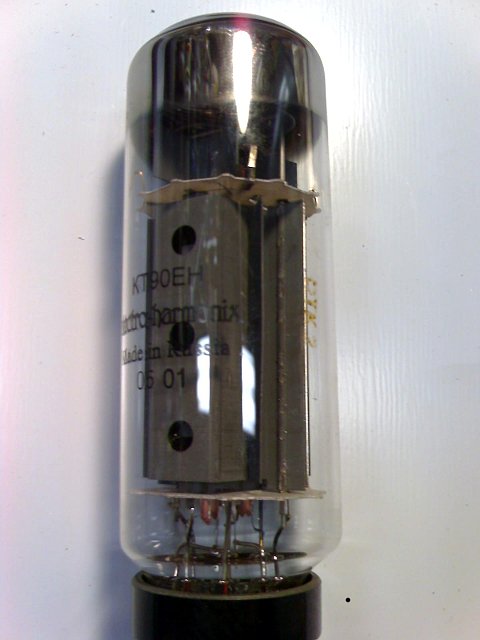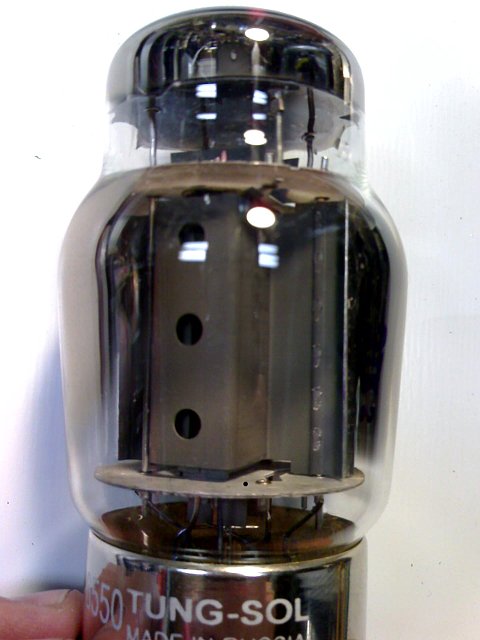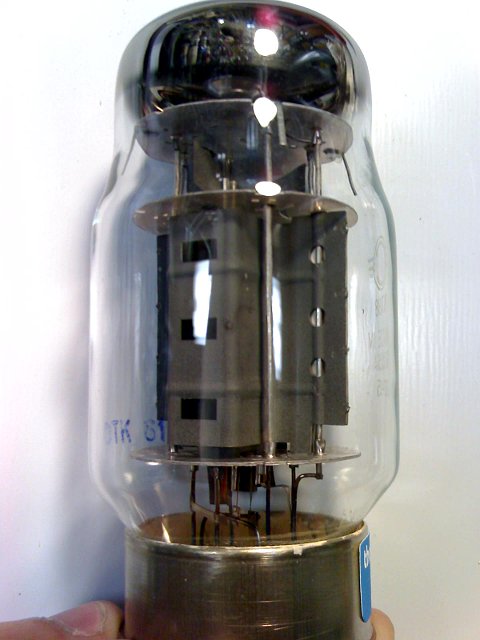although KT88's and 6550's have noticibly more bass than EL34's or 6L6GC's.
Have you tried the EH 6CA7? I've heard that they have more bass than EL34's, but haven't tried them in anything yet.
I've seen 2 types of EH 6550's floating around, some are strait bottles and some aren't. Anyone know the scoop on that?
Some 10 yrs ago I picked up several hundred 6550WA/B clear glass, zirconium pellet getter and find'em reliable despite very slow warm up...I complained to my vendor about this and got another 50 free so I became suspicious that they were manuf with incorrect heaters. Borrowing an infrared sensor and comparing with other 6.3V heaters of other 6550 series, I find the red spectrum exact at 6.5V not at 6.3V. So I run'em at 6.5V and all is happy. Without visible ident markings on tubes I cannot say this holds for all batches. In past, I believe both Sovtek and Svetlana manufactured the WA/B series but I could be wrong..The Svetlana B version was superceeded to the so claimed superior C version with gold plated grids. I have my doubts that gold plating does anything we ought to take notice of..
The 6550 WA/B straight sided transparent tubes in an amp chassis look rather boring with virtually no blueness in the dark. Historically, I haven't had one that failed outright on the bench nor sounded foul. Sonically sim as the Svet C version at a 1/3 of the price the WA/B is still available in surplus numbers at reasonable prices.
The distortion spectrum is low, sim to a good KT88 plugged in with adjustments, i.e end result no real differences..-However the proof test lies with FFT harmonic analysis which I intend to set up for.
The most beautifully engineered and ultimate performing KT88 was a Gold Lion replica made by the old salts of Tesla with a white base and highly sought after. .I never found a KT88 (even NOS) that bettered the results of this tube. Regretfully no longer produced. pic enclosed.
richy
The 6550 WA/B straight sided transparent tubes in an amp chassis look rather boring with virtually no blueness in the dark. Historically, I haven't had one that failed outright on the bench nor sounded foul. Sonically sim as the Svet C version at a 1/3 of the price the WA/B is still available in surplus numbers at reasonable prices.
The distortion spectrum is low, sim to a good KT88 plugged in with adjustments, i.e end result no real differences..-However the proof test lies with FFT harmonic analysis which I intend to set up for.
The most beautifully engineered and ultimate performing KT88 was a Gold Lion replica made by the old salts of Tesla with a white base and highly sought after. .I never found a KT88 (even NOS) that bettered the results of this tube. Regretfully no longer produced. pic enclosed.
richy
Attachments
I have my doubts that gold plating does anything we ought to take notice of..
I'm told it makes the tube much more fragile in AB2. This is consistent with my experiences, however I don't know how much power the grid was dissipating when I destroyed my tubes. Still, I'd pay well for quality KT88s without gold plated grids. Did KT88s and 6550s of the past have gold plated grids?
The advantages of gold plated grids are discussed in this 1950s article describing the 5881 as compared to the 6L6:
http://www.qsl.net/dl7avf/roehren/e5881.html
http://www.qsl.net/dl7avf/roehren/e5881.html
I found this statement a while back while searching for ham radio related material. These statements were found on this web site:
http://www.w8ji.com/
"In actuality, tungsten grids in tubes like 3-500Z's can be operated at temperatures where they show color without permanent damage. While tube operation at such temperatures is compromised, the grid and tube often suffers no permanent damage.
The same is not true for gold-plated grids, like those in metal-oxide cathode tubes. Grids plated with soft poorly-bound materials like gold suffer gradual long-term deterioration even with moderately low levels of grid current. Heat the grid of a metal-oxide cathode tube to temperatures even well below incandescence, and the result is instant irreversible failure."
http://www.w8ji.com/
"In actuality, tungsten grids in tubes like 3-500Z's can be operated at temperatures where they show color without permanent damage. While tube operation at such temperatures is compromised, the grid and tube often suffers no permanent damage.
The same is not true for gold-plated grids, like those in metal-oxide cathode tubes. Grids plated with soft poorly-bound materials like gold suffer gradual long-term deterioration even with moderately low levels of grid current. Heat the grid of a metal-oxide cathode tube to temperatures even well below incandescence, and the result is instant irreversible failure."
Ah, interesting, thanks for that link. It says with moderate grid current which does not apply to the more common amp designs. I noticed that you're into more exotic amps, but the average amp should not have G1 grid current unless there is a problem as I see it.
Not sure if they're plating the screen grid also, that could obviously be a problem.
Pete B.
Not sure if they're plating the screen grid also, that could obviously be a problem.
Pete B.
These are the beasts I have.
The guts of your tubes look the same as some Sovtek KT88's that I have. The date codes on them are 99 10 but they are in the "Tung Sol" shaped glass envelope. If they are the same guts they aren't bad tubes. They don't have the extra heat dissipating fins that the EH tubes have but sound similar and don't blow up when leaned on.
I wonder if the tubes shown are "real" Sevetlanas or some of the new ones made by Reflector? I've heard that the real ones are still available in the =C= brand is that true?
A long time ago I used a set of the Sevetlana 6550's in an Ampeg SVT that I repaired and fixed up for a guy and they were really nice tubes. Biasing was easy and they have been in that amp for a LONG time.
A long time ago I used a set of the Sevetlana 6550's in an Ampeg SVT that I repaired and fixed up for a guy and they were really nice tubes. Biasing was easy and they have been in that amp for a LONG time.
It says with moderate grid current which does not apply to the more common amp designs. I noticed that you're into more exotic amps, but the average amp should not have G1 grid current unless there is a problem as I see it.
Gold plated grids should be able to handle some grid current, otherwise the 5881 would not have AB2 suggested operating points. Just don't crank it to 11 with sine wave input. I cranked mine to 11 playing music for quite a while and didn't have problems.
Also, the drivers of yesteryear may not have been able to inflict nearly the punishment that source followers can.

I've had poor experiences with Ruby Tubes KT88s. Unfortunately I had purchased 28 of them in matched quartets over a couple years prior to actually using any of them. I would learn the hard way that 11 of the 28 had major failures very early in their life. Two provided a sparking light show right out of the box, while many others just quit conducting current after about 10 hours of usage punctuated with a few on/off cycles. Though the filament remained lit, plate voltage was still present at it's pin, and fixed bias voltage was still present in it's pin, the cathode current dropped to zero instantly, accompanied by a loud pop in the speakers. I run a 10 ohm cathode resistor on each of four tubes in PPP and monitoring current flow through each resistor, the voltage drop across the 10 ohm went instantly to zero for the affected tube.
When the amp is turned on from a cold start, everything powers up fine and the amp is working magnificently for awhile. Then suddenly a loud pop and one of the four tubes just stops conducting. This problem follows the specific tube, regardless of which amp I place it in. I have even retouched the solder inside the pin ... the problem persists.
After exhaustive testing, I believe the spot welds (or lack of them)between the anode plate material to the electrode wire are no good. Whatever spotwelding current is (might be) used during manufacturing, it may be adequate for small signal tubes with small plates and fine electrode wires, but is inadequate for the big plates and wires. OK, maybe I could accept an occcasional failure every couple years, but repeated failures inside of 10 operating hours, with multiple tubes having identical failure modes ... no .
Ruby's may have a replacement guarantee, but after experiencing the identical failure modes in an inordinately large percentage of the same tube numbers, NO, I am not interested in a replacement.
I am now purchasing Gold Lions.
When the amp is turned on from a cold start, everything powers up fine and the amp is working magnificently for awhile. Then suddenly a loud pop and one of the four tubes just stops conducting. This problem follows the specific tube, regardless of which amp I place it in. I have even retouched the solder inside the pin ... the problem persists.
After exhaustive testing, I believe the spot welds (or lack of them)between the anode plate material to the electrode wire are no good. Whatever spotwelding current is (might be) used during manufacturing, it may be adequate for small signal tubes with small plates and fine electrode wires, but is inadequate for the big plates and wires. OK, maybe I could accept an occcasional failure every couple years, but repeated failures inside of 10 operating hours, with multiple tubes having identical failure modes ... no .
Ruby's may have a replacement guarantee, but after experiencing the identical failure modes in an inordinately large percentage of the same tube numbers, NO, I am not interested in a replacement.
I am now purchasing Gold Lions.
- Status
- This old topic is closed. If you want to reopen this topic, contact a moderator using the "Report Post" button.
- Home
- Amplifiers
- Tubes / Valves
- New kt88's or 6550
